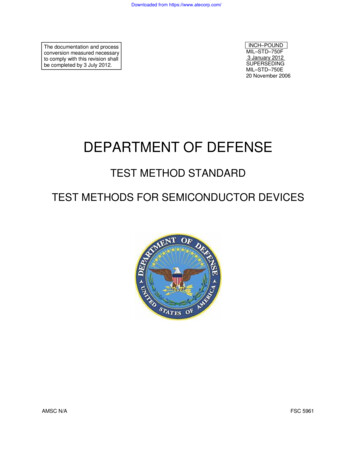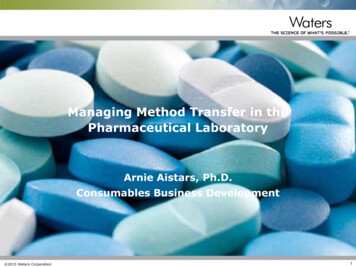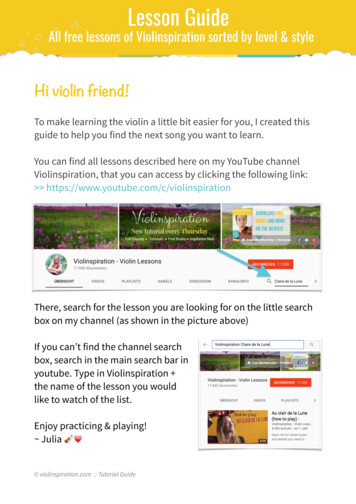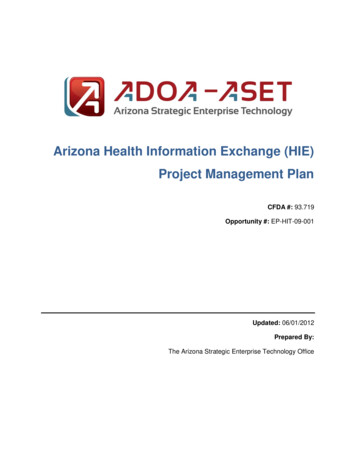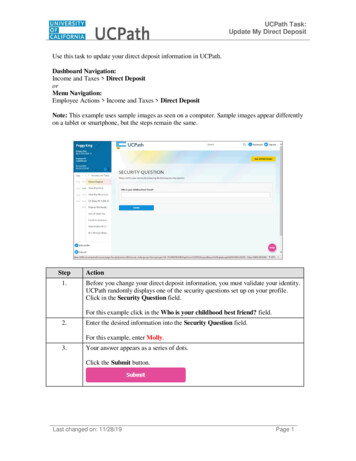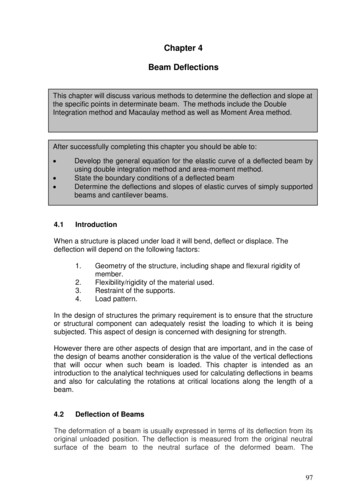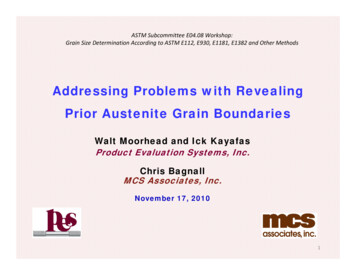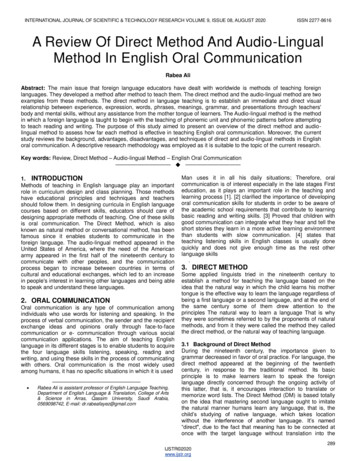
Transcription
INTERNATIONAL JOURNAL OF SCIENTIFIC & TECHNOLOGY RESEARCH VOLUME 9, ISSUE 08, AUGUST 2020ISSN 2277-8616A Review Of Direct Method And Audio-LingualMethod In English Oral CommunicationRabea AliAbstract: The main issue that foreign language educators have dealt with worldwide is methods of teaching foreignlanguages. They developed a method after method to teach them. The direct method and the audio-lingual method are twoexamples from these methods. The direct method in language teaching is to establish an immediate and direct visualrelationship between experience, expression, words, phrases, meanings, grammar, and presentations through teachers'body and mental skills, without any assistance from the mother tongue of learners. The Audio-lingual method is the methodin which a foreign language is taught to begin with the teaching of phonemic unit and phonemic patterns before attemptingto teach reading and writing. The purpose of this study aimed to present an overview of the direct method and audiolingual method to assess how far each method is effective in teaching English oral communication. Moreover, the currentstudy reviews the background, advantages, disadvantages, and techniques of direct and audio-lingual methods in Englishoral communication. A descriptive research methodology was employed as it is suitable to the topic of the current research.Key words: Review, Direct Method – Audio-lingual Method – English Oral Communication—————————— ——————————1. INTRODUCTIONMethods of teaching in English language play an importantrole in curriculum design and class planning. Those methodshave educational principles and techniques and teachersshould follow them. In designing curricula in English languagecourses based on different skills, educators should care ofdesigning appropriate methods of teaching. One of these skillsis oral communication. The Direct Method, which is alsoknown as natural method or conversational method, has beenfamous since it enables students to communicate in theforeign language. The audio-lingual method appeared in theUnited States of America, where the need of the Americanarmy appeared in the first half of the nineteenth century tocommunicate with other peoples, and the communicationprocess began to increase between countries in terms ofcultural and educational exchanges, which led to an increasein people's interest in learning other languages and being ableto speak and understand these languages.2. ORAL COMMUNICATIONOral communication is any type of communication amongindividuals who use words for listening and speaking. In theprocess of verbal communication, the sender and the recipientexchange ideas and opinions orally through face-to-facecommunication or e- communication through various socialcommunication applications. The aim of teaching Englishlanguage in its different stages is to enable students to acquirethe four language skills listening, speaking, reading andwriting, and using these skills in the process of communicatingwith others. Oral communication is the most widely usedamong humans, it has no specific situations in which it is used bea Ali is assistant professor of English Language Teaching,Department of English Language & Translation, College of Arts& Science in Arras, Qassim University, Saudi Arabia,0569098742, E-mail: dr.rabeafayez@gmail.comMan uses it in all his daily situations; Therefore, oralcommunication is of interest especially in the late stages Firsteducation, as it plays an important role in the teaching andlearning process [1]. [2] clarified the importance of developingoral communication skills for students in order to be aware ofthe academic school requirements that contribute to learningbasic reading and writing skills. [3] Proved that children withgood communication can integrate what they hear and tell theshort stories they learn in a more active learning environmentthan students with slow communication. [4] states thatteaching listening skills in English classes is usually donequickly and does not give enough time as the rest otherlanguage skills.3. DIRECT METHODSome applied linguists tried in the nineteenth century toestablish a method for teaching the language based on theidea that the natural way in which the child learns his mothertongue is the effective way to learn the language regardless ofbeing a first language or a second language, and at the end ofthe same century some of them drew attention to theprinciples The natural way to learn a language That is whythey were sometimes referred to by the proponents of naturalmethods, and from it they were called the method they calledthe direct method, or the natural way of teaching language.3.1 Background of Direct MethodDuring the nineteenth century, the importance given togrammar decreased in favor of oral practice. For language, thedirect method appeared at the beginning of the twentiethcentury, in response to the traditional method. Its basicprinciple is to make learners learn to speak the foreignlanguage directly concerned through the ongoing activity ofthis latter, that is, it encourages interaction to translate ormemorize word lists. The Direct Method (DM) is based totallyon the idea that mastering second language ought to imitatethe natural manner humans learn any language, that is, thechild’s studying of native language, which takes locationwithout the interference of another language. It’s named―direct", due to the fact that meaning has to be connected atonce with the target language without translation into the289IJSTR 2020www.ijstr.org
INTERNATIONAL JOURNAL OF SCIENTIFIC & TECHNOLOGY RESEARCH VOLUME 9, ISSUE 08, AUGUST 2020native language. The Direct Method is a result of the grammartranslation method, and it shifts from literary language tospoken language [5] and it gives more emphasis to teachingaural-oral skills [6]. Using the direct method in teachingEnglish is that teaching English through the target languagedirectly. According to the current study, the target language isEnglish. Teachers don't use the native language in teachingand students don’t use it. This method doesn’t agree with ofGrammar Translation Method. Many teachers follow thismethod in teaching English. One of the advantages of thismethod is that learners practice the target language toenhance their aural-oral skills while they are comfortable withtheir mother tongue language [7]. This is the natural methodand anti-grammatical method developed as a response to themethod of translation of the grammar [8]. Specific approachadvocates like Frank and Brown agree that FL could be taughtwithout translation like what was published in Richards andRodgers on Approaches and Methods in Language Teaching[9]. Direct Method establishes a direct or instant relationshipbetween practice and expression, between the Englishvocabulary, phrase or idiom and its meaning throughsubstantiation, exaggeration without the use of the firstlanguage. This method aims to help students to learn the wayof communication in the target language as they learnedcommunication skills of their native language.3.2 PRINCIPLES OF DIRECT METHODThis method focuses on oral practice for everyone and itemphasizes on the functional grammar (that is taughtinductively) not theoretical grammar. Moreover, direct methodsupports using daily-use words. The concrete vocabulary istaught through demonstration, pictures, and objects. Thathelps students develop an understanding of meaning. On thecontrast, the abstract vocabulary is taught via connection ofideas. The words should be related to learners’ needs.Classroom instruction is shown entirely in the target language.Oral communication skills are shown through question-andanswer exchanges between teachers and students in small,intensive classes. Teachers focus attention on correctpronunciation and grammar. It is not allowed to use the nativelanguage in the classroom. It is important to use the directmethod through the culture of the target language.3.3 Direct Method Teaching Techniques[10] mentioned some techniques related to the audio lingualmethod:1. Dialogs memorization: Students have ability to memorizedialogs via imitation.2. Backward Build-up (Expansion Drill): teacher divides asentence into some parts; students begin to repeat each partfrom the end of the sentence and "expanding" backwardsthrough the sentence, adding each part in sequence. Studentsrepeat teacher's model as quickly and accurately as possible.3. Chain drill : Students can practice this skill by asking andanswering each other one by one in a circular chain aroundthe classroom.4. Single-slot Substitution drill: Teacher states a line from thedialogue, and then uses a word or phrase as a "cue" thatstudents, when repeating the line, must substitute into thesentence in the correct place.5. Multiple-slot Substitution drill: Same as the single slot drill,except that there are multiple cues to be substituted into theline.ISSN 2277-86166. Transformation drill: Teacher provides a sentence that mustbe turned into something else, for example a question to beturned into a statement, an active sentence to be turned intonegative statement, etc.7. Question and Answer drill : Students should answer or askquestions very quickly.8. Use Minimal Pairs Analysis: teacher selects a pair of wordsthat sound identical except for a single sound that typicallyposes difficulty for the learners-students are to pronounce anddifferentiate the two words.9. Complete the dialog: Selected words are erased from a linein the dialog-students must find and insert.10. Grammar games: Various games designed to practice agrammar point in context, using lots of repetition. In the AudioLingual method, the classroom atmosphere is the main actor.3.4 Advantages of Direct Method in Teaching English OralCommunication:1. The more focus is on Oral Practice so the communicationskills improve.2. This method is suitable for teaching vocabulary and itsbranches such as words and idioms.3. This method helps learners to be fluent in communicationskills.4. Teacher move from particular to general and from concreteto abstract.5. It makes the teaching English easier and more pleasant.6. This method generates suitable and active learningenvironment for English oral communication.7. English learners speak complete sentences with otherswithout hesitation.3.5. Disadvantages of Direct Method in Teaching EnglishOral Communication:1. Reading and writing skills are neglected as the directmethod focuses more on oral practice.2. Regular students, especially from rural background, faceproblems to understand the things that they want to learnthrough this method.3. Teachers suffer from the expensive aids that they usethrough this method.4. By using this method, there are competent teachers.5. This method is not suitable for learners in the early stage oflearning.6. To make this method effective, it is better if learners haveforeign language background at home.3.6. Direct Method with English oral CommunicationThe direct method is one of the teaching methods thatteachers use to teach a non-native language. Hence, if somestudents do not understand some of the spoken words by theteacher, it is not permissible for the teacher to translate, but hecan display clear visual means (based on the direct method)for these words, which help students to learn English oralcommunication in a fun way.[11] The direct method of teachinglanguages plays an important role in developing oralcommunication skills. This role is clear among educationalscientists as many studies proved that Direct Method has apositive effect on English oral communication. Accordingly,[12] declared that using direct method in teaching English oralcommunication has a positive response towards students [13]showed that using the Direct Method in teaching can develop290IJSTR 2020www.ijstr.org
INTERNATIONAL JOURNAL OF SCIENTIFIC & TECHNOLOGY RESEARCH VOLUME 9, ISSUE 08, AUGUST 2020the students’ speaking skill they were more motivated andmemorized the target structure well. On the other hand, usingthis method in teaching English oral communication skillsfaced a criticism from some educators (professors of thePennsylvania State University), who assert that the success ofthis method depends on the teacher being able tocommunicate verbally to the target language, such as hisability to the mother tongue, as students will not be perfect inthese skills unless the teachers themselves will. They addedthat teachers, who use this method, should have somecharacteristics like stamina, energy, imagination, time todesign and tact in the target language an ability to persuade,and quick-wittedness in various teaching situations [6].--AUDIO LINGUAL METHOD-4.3 Background of Audio Lingual MethodAudio Lingual Method is one of methods of teaching foreignlanguages and it is based on behaviorist theory. This methodis a method of teaching reading in English language bydeveloping phonological awareness, that is, the ability todistinguish sounds, in order to teach the interconnectionbetween these sounds and the letters that represent them tostudents. Also, students listen to / or watch records of differentposition models for second language speakers and practice avariety of exercises, and the instructor emphasizes the use ofthe target language at all times. This method was used by theUnited States Army; to teach soldiers foreign languages usedin the case of directing instructions during the war or theoccurrence of certain incidents, and that was during theSecond World War, and because of poor performance andscientific output for this method, it is rarely the main means ofteaching the second language, but it is used as an aid toeducation and for training on exam patterns in internationallanguage exams.[14]4.4 Principles of Audio Lingual MethodIt is one of the most important foundations of this method isthe extensive use of audio-lingual aids, and the use of variousmethods to teach the language, such as simulation, repetitionand memorization, and focusing on the method ofmeasurement, with less explanation, and grammaticalanalysis. Instead students are trained focused on languagepatterns and grammatical structures. According to [15], thereare some principles related to this method.English language skills are presented gradually.The best teacher of the language is the nativespeaker.The texts are presented in the form of dialogues.It relies on the principle of commonality in providingvocabulary and structures.Vocabulary is offered in a limited number.Learning vocabulary is from context.Learning Aids are used a lot.It is interested in practicing the language.It cares about correct linguistic and pronunciation ofsounds.4.5 Advantages of Audio Lingual Method in TeachingEnglish Oral Communication:It emphasizes the communicative aspect of teachinglanguages.It is interested in language culture, thinking aboutlanguage.It is interested in using aids, and paying attention toexercises.It graduated in language presentation.It adjusts vocabulary and structures to learners.4.6 Disadvantages of Audio Lingual in Teaching EnglishOral Communication:--4ISSN 2277-8616Repetition is good but there are faster methods thatshould not be ignored.The separation of language skills does not meet theneeds of all learners.It doesn’t meet individual differences (everyone hears- everyone repeats).It is interest in listening and speaking at the expenseof reading and writing skills.4.7 Audio Lingual Method TechniquesRepetitionThe learner repeats the spoken phrase by simplylistening to it without looking at the written text, and itis best if the spoken form is short so that the audiomemory is easy to keep. Voice is just as important asdesigning sentences. After the student repeats thephrase, he can repeat it again and add a few words toit then repeat the whole sentence and add otherwords to it. The learner hears a direction and thenforwards that matter to another person according tothe instructions.ComplementThe learner listens to a sentence from which oneword is removed, and the learner must repeat thatsentence in its entirety. When a word is added to thesentence, this necessitates a change in the location ofthe word.ContractionIt is to replace a word with an expression or phrase.The sentence has been transformed by making it anexile or interrogative sentence, or by changes in time,mood, and construct, known or unknown, voice andface, or the possibility of a modality.MergingThe learner is required to combine two separatesentences into one sentence via a link.CommentAnd that is for the learner to respond appropriately tothe given sentence so that his response is among thealternatives that have been identified for him before.RebuildIn this type of activity, the learner gives a set of words that arechosen from a sentence, but they are still different in the basicsense of the sentence. He must use those words with somechanges and additions, within very narrow limits, to restore thesentence to its original nature.4.8 Audio-Lingual Method with English OralCommunicationThe audio-lingual method treats language as aform of human habits, especially with the speakingskill, which requires the speaker's fluency. Accordingto this method, training is the basic strategy in291IJSTR 2020www.ijstr.org
INTERNATIONAL JOURNAL OF SCIENTIFIC & TECHNOLOGY RESEARCH VOLUME 9, ISSUE 08, AUGUST 2020--teaching English oral communication skills, where thefirst step is simulation, and the teacher continues withsolidarity in this step until students master thepronunciation of words or sentences to be learned.Moreover, Teachers remain the guides for students intraining them in English oral communication skills byrepeating those sentences many times [16]. TheAudio Lingual Method helps learners to be highlyefficient and courteous in communication with others,as well as quick reaction in talking to others [17].After the author showed a review of direct method andaudio-lingual method in English Oral Communicationthrough previous sections, he noticed that the twomethods can be used and they have some similaritiesand differences. The similarities are the materialreaches students using the target language, there isno place to explain about grammar and be interestedin talking, and the teacher should do a great jobbecause they need a lot of time, using them needsteaching aids, and the teacher should have eloquentspeech. On the other hand, the differences are stepsof using an audio-lingual method start with listening tothe dialogue and then mimic sentence after sentencein talk but using of the direct method begins usingvocabulary and then speech. The two methods aresuitable for developing English Oral Communicationbut they are different in applying them.Although the audio-lingual method is consideredone of the traditional methods in teaching and itsusers are seen old-fashioned, the researcher believesthat it is suitable to be used in teaching English oralcommunication as this method focuses onpronunciation and the needed skills of oralcommunication. This opinion agrees with manystudies like [18] study that states the positive effect ofusing the audio-lingual method in teaching speakingskills, [19] study that showed the importance of usingaudio-lingual methodto improve the students’listening skill through phonetic symbols, [20] thatproved the benefits of using Audio-Lingual method inteaching speaking skills, [21] who declared that theaudiolingual method focuses on repetition somewords to memorize which helps students to build theiroral communication, [22] study proved that the audiolingual method can enhance speaking skills like thetopics that need comprehending being communicatedfluently; selecting the suitable vocabularies for theblanks in the conversations; pronouncing thevocabularies and expressing sentences in goodintonation and pronunciation; and using the correctstructures during applying the audio-lingual method;Richards and Rodgers [23] study that stated that thismethod is a perfect method to be used in teachingforeign or second language as it gives the priority tolistening and speaking before reading and writing inteaching language skills.CONCLUSIONAfter the author showed a review of direct method and audiolingual method in English Oral Communication throughprevious sections, he noticed that the two methods can beused and they have some similarities and differences. Thesimilarities are the material reaches students using the targetISSN 2277-8616language, there is no place to explain about grammar and beinterested in talking, and the teacher should do a great jobbecause they need a lot of time, using them needs teachingaids, and the teacher should have eloquent speech. On theother hand, the differences are steps of using an audio-lingualmethod start with listening to the dialogue and then mimicsentence after sentence in talk but using of the direct methodbegins using vocabulary and then speech. The two methodsare suitable for developing English Oral Communication butthey are different in applying them.Although the audio-lingual method is consideredone of the traditional methods in teaching and itsusers are seen old-fashioned, the researcher believesthat it is suitable to be used in teaching English oralcommunication as this method focuses onpronunciation and the needed skills of oralcommunication. This opinion agrees with manystudies like [17] study that states the positive effect ofusing the audio-lingual method in teaching speakingskills, [18] study that showed the importance of usingaudio-lingual methodto improve the students’listening skill through phonetic symbols, [19] thatproved the benefits of using Audio-Lingual method inteaching speaking skills, [20] who declared that theaudiolingual method focuses on repetition somewords to memorize which helps students to build theiroral communication, [21] study proved that the audiolingual method can enhance speaking skills like thetopics that need comprehending being communicatedfluently; selecting the suitable vocabularies for theblanks in the conversations; pronouncing thevocabularies and expressing sentences in goodintonation and pronunciation; and using the correctstructures during applying the audio-lingual method;[22] study that stated that this method is a perfectmethod to be used in teaching foreign or secondlanguage as it gives the priority to listening andspeaking before reading and writing in teachinglanguage skills.REFERENCES[1] Thapa, A., Cohen, J., Guffey, S., & Higgins-D’Alessandro,A, ―A review of school climate research,‖ Review ofEducational Research, 83(3), 357–385,(2013).[2] Raghavendra, P., Olsson, C., Sampson, J., Mcinerney, R.,& Connell, T, ―School participation and social networks ofchildren with complex communication needs, physicaldisabilities, and typically developing peers,‖ Augmentativeand Alternative Communication, 28(1), 33–43, (2012).[3] Mostafa, M. K. I, ―The Effect of Chants and Short Storieson Primary Stage Pupils’ Communication and Attitudes,‖World Journal of Educational Psychology, 1(doi: 10.11),pp-1, (2017). Bumandalai, U,‖The Development of TwoUnits for Basic Training and Resources for TeachingEnglish to Speakers of Other Languages: "DevelopingEnglish Language Learners' Listening Skills" and"Developing English Language Learners' Speaking Skills".M.A. thesis, The Brigham Young University, U.S.A. (2013).[4] Qing-xue, L., & Jin-fang, S, ―An analysis of languageteaching approaches and methods effectiveness andweakness‖, US-China Education Review, 4(1), 69-71,(2007).[5] Cagri Tugrul Mart, ―The Direct-Method: A Good Start to292IJSTR 2020www.ijstr.org
INTERNATIONAL JOURNAL OF SCIENTIFIC & TECHNOLOGY RESEARCH VOLUME 9, ISSUE 08, AUGUST 2020Teach Oral Language,‖ International Journal of AcademicResearch in Business and Social Sciences, November2013, Vol. 3, No. 11,2013.[6] Raja, B. W. D., & Selvi, K,. ―Causes of problems inlearning English as a second language as perceived byhigher secondary students‖, i-manager's Journal onEnglish Language Teaching, 1(4), 40-45, (2011).[7] Gay, L.R. & Airasian, P, ―Educational research:Competencies for analysis and application‖ (7th Ed.),Upper Saddle River, New Jersey: Pearson education,Journal of Language Teaching and Research 5(3): 559–565, (2003).[8] Richard, J. C., & Rodger, T. S, ―Approaches and Method inLanguage Teaching: Communicative Language Teaching‖,Cambridge University Press, (1999).[9] Shamsiddinovna, I. D., & Bakhtiyarovna, Z. N, ―ApplyingAudio lingual Method in English lessons‖, InternationalJournal of Psychosocial Rehabilitation, 24(2), 1297–1300,(2020).[10] Richards, J. & Rodgers T, Approaches and Methods inLanguage Teaching, Cambridge: Cambridge UniversityPress, (2007).[11] Nadia Batool,Muhammad Anosh , Anam Batool , NadeemIqbal, ―THE DIRECT METHOD: A GOOD START TOTEACH ORAL LANGUAGE‖, International Journal ofEnglish Language Teaching. Vol.5, No.1, (2017).[12] Andriyani, N, ―USING THE DIRECT METHOD INTEACHING TO IMPROVE STUDENTS’ SPEAKING SKILLAT PURIKIDS LANGUAGE COURSE‖, NIVERSITY, (2015).[13] Sharpe, A. E, ―An evaluation of the audio-lingualmethod‖, International forum of teaching and studiesjournal, 5(2): 1-12, (2018).[14] Anabokay, Y. M, ―TEF Method in Indonesia‖, InternationalJournal of Linguistics, Literature, and Culture, 5(2): 1324, .[15] Xia Y, ―Language theories and language teaching‖: Fromtraditional grammar to functionalism, (2014).[16] Khan, R. M. I., Radzuan, N. R. M., Shahbaz, M., &Ibrahim, A. H, ―Efficacy of methodological practicesundertaken by Saudi English teachers in publicschoolsduringtheirformative phase‖, EnglishReview: Journal of English Education, 7(2): 47-54, (2019).[17] Brown, H.D, ―Teaching by Principles: An interactiveApproach to Language pedagogy‖; 2nd Ed. New York:Pearson Education Company, (2001).[18] Zuhrotun Samawiyah andMuhammad Saifuddin,―Phonetic Symbols through Audiolingual Method toImprove the Students’ Listening Skill‖ DINAMIKA ILMU.Vol. 16 No. 1, (2016).[19] Amelia, Putrinda Dwi, ―The Implementation of AudioLingual Method In Teaching Speaking To The Eighth YearStudents of MTs Al-Ikhlas Mayung – Cirebon‖, Thesis.English Study Program Tarbiyah, Faculty Syekh NurjatiState Institute For Islamic Studies, IAIN Syekh NurjatiCirebon, (2012).[20] Freeman, D. L,. ―Techniques and Principles in LanguageTeaching (Second ed.)‖,. Oxford: Oxford University Press,(2000).[21] Eda Maaliah, Yulius Harry Widodo, and Muhyiddin AzizPoliteknik Negeri Madiun, ―USINGAUDIO-LINGUALMETHOD TO IMPROVE THE STUDENTS’ SPEAKINGISSN 2277-8616SKILL‖,. Journal Bahasa Inggris Terapan Vol 3/Number1/February 2017.[22] Richards, Jack C. and Rodgers, Theodore S, ―Approachesand Methods in Language Teaching. New York:Cambridge University Press, (2001).293IJSTR 2020www.ijstr.org
3.4 Advantages of Direct Method in Teaching English Oral Communication:- 1. The more focus is on Oral Practice so the communication skills improve. 2. This method is suitable for teaching vocabulary and its branches such as words and idioms. 3. This method helps learners to be fluent in communication skills. 4.
